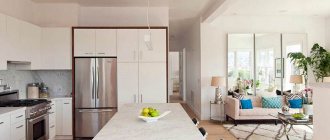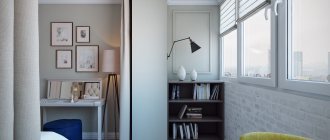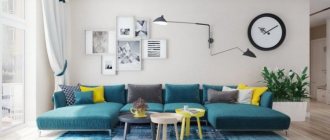Home » Design
Living RoomDesignFurnitureBedroom
Belyaeva Irina
55630 Views
Zoning a room into a bedroom and a living room is a way to divide the space of a large room. Combining the functions of a bedroom and a living room in one room is a fairly common situation. It folds up when arranging a small apartment or studio apartment. Creating a functional and attractive interior is not an easy task, but it is quite feasible. Let's try together to choose options that you will definitely like.
Single space – is it good or bad?
A room that combines several functions has disadvantages and advantages that need to be mentioned.
The advantages of a single space include the following:
- the ability to create an interesting original layout;
- allocation of personal space even with a small square footage;
- adding practicality to the room.
There are also negative points:
- there is no possibility to organize soundproofing of the sleeping area;
- the bedroom does not provide intimacy.
Take everything into account when zoning a room
Most often, a room combining several functions is designed in a minimalist or modern style. Good classicism requires more space than a modestly sized room can provide. Laconic pieces of furniture are chosen for it, as well as discreet decor so as not to overload the interior.
Don't overload the interior of the room
Using partitions for zoning
To create partitions when zoning a room, a wide variety of materials can be used - glass, plastic, wood, as well as fiberboard. The partition can be either stationary or mobile.
Zoning approaches - choosing the optimal one
Combining several zones with different functionality is a fascinating process. It is necessary to proceed from the fact that the space should not only be comfortable, but also stylish. There are several approaches for this.
Two main groups of zoning options:
Irreversible, which include serious repair and construction work with the installation of partitions, podiums, and other structures.
Irreversible designs in the interior
Reversible, the use of which is less expensive. To implement design ideas, screens, curtains, and separation by rearranging furniture are used.
Screen when dividing space
Walls: a game of contrasts
If you don’t have a lot of money allocated for renovation and dividing the room into a bedroom and a living room, you can give preference to wallpaper of different colors. Highlighting with photo wallpaper will look beautiful and original.
Photo wallpaper to accent the bed
To avoid getting into trouble, you need to consider some important points:
- for small rooms it is better to prefer a small print to a large one;
- an acceptable option is a general color scheme;
- it is desirable to organize a smooth transition of shades;
- A small pattern is preferable to a large one.
Techniques for dividing zones
There are many possibilities to delimit zones that carry different functions, but in each specific case they are guided by the general style of the room and its area. Interior designers note that different zones are still united by a common space and cannot compete with each other, and the dividing element must fit organically into the interior.
>Important! To create harmony and comfort in both zones of the room, furniture and decorative elements of the same color are used.
So, let's look at possible zoning options:
- partitions (mobile or stationary);
- arches;
- racks;
- cabinets;
- screens;
- sliding sliding doors;
- curtains.
And now more about each of the listed elements.
Partitions
To make a partition, which is used to zone a room, you can use almost any building material - brick, foam blocks, aerated concrete. It can be low or blank, with built-in niches or other additional decorative details. But, if sound insulation for the sleeping area is not important, then it is easier to install a partition made of plasterboard sheets on a metal frame.
Important! Installing partitions is only suitable for impressive rooms; in rooms with a small area they will look awkward and cumbersome.
But even for modern studios, installing stationary partitions is not the right solution, because the layout of such apartments places the main emphasis on the absence of partition walls. If it is necessary to erect this element in a room with a large area, partition the space so that there is at least one window in each part of the room. If this is not possible, and part of the room is left without natural light, it is more rational to install a light-transmitting partition, for example, glass. A similar partition can be built from frosted glass of various textures and shades, or you can make a custom stained glass window. When using completely transparent glass, the partition is complemented with a curtain made of thick fabric.
Important! The glass for the partition must be durable - special or tempered. This minimizes the risk of injury.
The separating elements are not necessarily made stationary; there are also many mobile versions. For example, glass or any other partitions in a metal frame cope excellently with the assigned functions, but are not “tightly” attached to the base, allowing you to redesign the space or completely remove this object that has become unnecessary. A modern and stylish zoning technique and design element are photo paintings framed in a metal frame and installed as partitions.
Curtains
You can separate the sleeping area from the living room using curtains. The variety of design textile ideas is enormous. Curtains can be flowing and translucent, flowing soft folds, or dense heavy curtains.
Advice! Having the dividing curtains and window curtains share the same color scheme will facilitate the visual perception of the overall space of the room. But the textures of the fabric can be completely different - this will emphasize the isolation of zones.
An excellent solution for separating a certain sector is a design technique such as curtains made of different-sized beads, bamboo, designer balls, etc.
Shelving
A lightweight and no less decorative option for delimiting space is a shelving unit. This technique is universal and is suitable for rooms of any size due to its transparency and functionality - working as a border separator, it also carries a practical load - as a rule, all sections of the shelving are filled with books, magazines, photographs, and other small items.
Advice! For some shading of the sharp boundary between zones, it is advisable to choose designer shelving of unusual shapes.
Arches
These lightweight designs are usually arched, traditional and versatile. They fit organically into a room of any size, decorating it and dividing it into functional zones. The materials used for the construction of arched spans are varied: plasterboard, decorative grilles, stained glass, etc. are used here.
Sliding doors
Installing such a door is a widespread design technique that simultaneously pursues two goals: decoration and dividing the room into two zones. Making such a movable partition in a mirrored version or using stained glass will give the living room a certain elegance, and the seating area can be completely isolated if desired. In addition, the use of mirror surfaces visually enlarges the small area of the room.
Screens
Mobile dividing elements also include various portable screens, which are a structure of several interconnected frame frames. They take up little space, but work functionally, delimiting zones. The use of screens in rooms with a small area is especially important.
Advice! By choosing a screen that completely covers the bedroom area, but does not reach the ceiling, the visual integrity of the room is preserved.
Factors such as color, texture of finishing materials and decorative elements, difference in room height, and appropriate arrangement of furniture also participate in the division of space.
A ceiling that solves the problem of highlighting zones
For a one-room apartment of a small area, zoning a room is not an easy problem. When planning a division, it is advisable to use techniques that allow you to visually expand the space. A tool for this can be ceiling design.
Ceiling with different lighting for zones of the room
Ways to highlight zones using a ceiling:
- Sectional painting.
- Plasterboard structures.
- Manipulation of ceiling lights (chandelier, spotlights).
Wardrobe as a delimiter: pros and cons
Using a closet as a space divider is an old trick that has been used for many years. It allows you not only to reliably cover the bed, but also to solve the problem of storage space.
Wardrobe in living room and bedroom zoning
For additional convenience, you can mount the TV on a rotating mechanism at the border of the zones. By turning the TV, you can watch TV shows either while lying on the bed or sitting on the sofa in the living room.
The shelving between the zones also serves to divide the space. A model with a back wall and a light shelf are also suitable for this. The division, just like in the case of a closet, is functional.
Great solution for extra storage
A rack and cabinet add a feeling of bulkiness to the room, so this method of zoning is not suitable for small apartments.
Closet
Divides the room and serves for storing things. The best option is custom-made furniture according to individual measurements. Plus: it creates a dense partition, which is important when dividing a bedroom into a child’s room and an adult’s. A caveat: the closet hides part of the usable space, so the solution is not suitable for small spaces.
An original solution: a wardrobe with a built-in bed. This option is suitable for families with children. During the daytime, the sleeping area is raised and useful space is freed up.
Partitions: changing the perception of space
A plasterboard partition will be a simple way to divide without the need for complex repairs. The use of plastic creates a feeling of lightness.
Durable materials for partitions have their advantages. With proper design, they can be adapted to organize storage systems. To do this, they provide for the creation of shelves and niches in which books, trinkets, and photographs can be placed.
Designed for what matters
The partition system must be combined with the interior. It should not block lighting or interfere with free passage.
For large apartments, a plasterboard partition can be a good solution. With its help, it is possible to organize a false wall up to the ceiling or limit yourself to a low structure.
When installing a low plasterboard wall, good lighting is maintained and ventilation is possible. If you cannot do without a high wall, you can organize the passage in the shape of an arch or using curtains.
Successful low plasterboard construction
For interior solutions, plasterboard is one of the convenient materials for design. The design and color should be combined with the interior of both zones. It can not only be cut to the desired size, but also combined with various types of finishes:
- wallpaper;
- putty;
- painting, etc.
Rectangular or arched plasterboard arches look beautiful and original.
Modern layout through design
Fans of open planning, which allows them to maintain space and freedom in medium-sized rooms, use various decorative techniques to create an interior.
Wall decoration can visually separate rooms
The accent design combines the sleeping area and the living room area into a single composition that does not interfere with each other. For registration use:
- original wall cladding;
- textile products;
- texture and shades of floor coverings;
- a decorative baluster that continues the molding on the wall;
- stucco;
- relief image from plasterboard on the wall;
- combining materials with different textures.
The classic option for separating two zones
A border made from floor pots with indoor plants or a tall narrow aquarium, an arched or straight arch looks interesting. The use of bamboo or beaded curtains simply marks the boundaries, maintaining the unity of the style direction of the room.
The use of screens that move in both directions allows you to change the area for sleeping. In the evening it moves towards the living room area.
We separate the area for sleeping using curtains in the nursery
Different designs of walls, flooring and ceiling surfaces allow you to delimit space. For example, in the bedroom there is a tactilely pleasant carpet, in the living room there is laminate or carpet.
Decorate the walls of each zone with wallpaper of different tones, patterns or textures. The combination of contrasting shades, textures, and characteristic properties of modern materials makes it easy to achieve a harmonious result.
Zoning in a small room
For the living room it is better to use bright colors, for bedrooms - calm shades that do not irritate the eye.
An excellent design combination for zones is textiles. For example, the same upholstery of chairs and a soft headboard, matching shades of curtains and bedspreads, patterns on wallpaper and colors of window curtains.
Textiles serve as an excellent combination
Sliding doors - how convenient are they?
In order not to lose a single centimeter of space, you can use a room division using a sliding door system. In this case, two independent zones will be organized. With a closed door, the impression of separate rooms is created, and with an open door, a single space appears.
Save space with sliding doors
This approach has its drawbacks. If the room is narrow and long, with only one window, then the separated part may have a serious drawback - a decrease in the level of natural light. You can use doors made of frosted or corrugated glass, which has high light transmittance, but allows you to hide the sleeping area.
High-quality sliding systems have a high cost.
With the help of screens, it is possible to isolate only a sleeping place or a fragment of a room with other pieces of furniture. This division is characterized by high mobility - the screen can be folded, rearranged, opened fully or partially. Partitions in a color that matches the overall design of the room will look original and non-standard.
The screen allows you to separate any space
For the loft style, this method of separating space is one of the most interesting. In addition to the oriental design, screens made from natural materials are selected. They can be mirrored, with painting and other additional decor.
Zoning with color and finishing materials
The combination of different finishing materials is a classic technique for zoning a bedroom and living room. Laminate goes well with floor tiles; you can lay a carpet next to a bed or sofa. And this is not to mention all the variety of wall decoration: companion wallpaper, paint, panels, brick or stonework.
Color accents are another powerful zoning tool. To make the room seem more spacious, use neutral and light colors. But if you have enough space, you have the most original and rich shades and combinations at your disposal.
One bright wall against a neutral background looks good: for example, behind a sofa or at the head of a bed. Niches, plasterboard structures or partitions are painted separately. Another technique is to use one or adjacent shades, but different expressive textures.
Multi-level tension or plasterboard structures are used on the ceiling. The first ones are simpler and more compact, but do not provide such impeccable geometry. Seconds are more varied, but larger, so they rarely fit into a small bedroom-living room.
Be sure to use light and a combination of different pendant or built-in lamps. For local lighting, night lights, table lamps, LEDs, neon, and duralight are suitable. Such techniques are suitable for complex modeling of space, uniform illumination of different zones and visual enlargement of the room.
Color options for the bedroom-living room
It is extremely difficult not to get confused when choosing the main palette for the interior. The spectrum is wide, but you need to be able to combine it correctly. And this is a difficult task for the average person. Knowing some of the nuances will help simplify it.
Mixing contrasting colors is fun, but you need to approach this issue carefully. When zoning, it is better to put bright accents on furniture or division boundaries, but not to completely decorate the bedroom or living room with them. The conflict of shades splits up the space and visually reduces it.
Monochrome is not always boring and monotonous. One color can have several dozen tones. When combining them, you can refuse to use decorative partitions.
For rooms of any functional purpose, such universal options as beige, gray, black, and white are suitable. They can be bright or muted. They are often used to decorate the walls of the living room and bedroom.
Curtains - a budget option
A simple and not very expensive way to separate a bedroom is to use curtains. For this, both thick textiles and light weightless tulle can be used. You can organize either a smooth transition between the living room and the bedroom, or an abrupt one.
One of the original and very aesthetic ways of zoning is using thread curtains. Monochrome or playing with all colors, such curtains can completely transform a room, introducing something new into it.
You can organize the fastening of curtains in various ways. For this, a rack system, a rod cornice, or the method that your imagination suggests is suitable.
Sharp separation of the bedroom from the living room
How to make curtains not look boring and uninteresting? The choice of material decides a lot. Heavy tapestry fabric will serve as reliable protection, while thin tapestry will create a feeling of lightness.
The selected fabric must withstand cleaning - washing and ironing.
The combination of materials that combine with each other looks beautiful. It can be satin and organza. It is necessary to take into account the correspondence of the curtains not only to the style of the room, but also to the curtains on the windows.
In addition to fabric curtains, the following materials can be used in the design:
- bamboo;
- beads;
- threads and other decorative elements.
Thread curtains with beads in the interior of the room
Textile zoning
Curtains are an excellent material that can be used to zone a room. Choose a color and texture that matches the chosen interior style.
Another interesting option is blinds or Japanese curtains. Japanese curtains are something between sliding doors and textile curtains. They will look very elegant and practical.
Several zones in a small room: the impossible is possible
For those who live in a one-room apartment or do not have the opportunity to allocate a full bedroom and living room, zoning becomes the only way out. If you choose a zoning option with a stationary partition, you must take into account that such a division will be designed for many years of operation without the ability to make changes quickly.
Dividing a one-room apartment into zones with a shelving unit
The best privacy when used for zoning furniture is created by tall cabinets and shelving. Curtains as a demarcation are a budget-friendly and simple option, in which the curtains can be changed frequently, to suit your mood or depending on the time of year.
Successful examples of redevelopment - moving walls wisely
As a rule, the decision to turn a one-room apartment into a two-room apartment using an additional wall is associated with the need to delimit personal space for several family members. In this case, you need to come to terms with it in advance - one of the halves cut off by the wall will be left without a window.
To avoid getting a stub of a normal room and a dark closet instead of a spacious room, you need to carefully think through the decor and lighting system. When artificially dividing a one-room apartment, designers recommend actively using mirrors in decoration and, if possible, building not blank walls, but translucent partitions that let in light.
The Moscow construction complex took into account the massive desire of Russians to remodel the space of small standard apartments and developed an entire official album of permitted redevelopments. The catalog includes construction ideas that comply with the basic requirements of current regulations and do not require additional approval. This information is especially useful for owners of older homes on the secondary market - modern new buildings, as a rule, are designed more intelligently. For example, a one-room apartment in a house of the I-1723 series can be legally converted in accordance with the different needs of the family - to separate the bedroom from the living room or to carve out a small office.
Both redevelopment options do not involve a significant change in the configuration of the housing - the kitchen and bathroom remain in their places, only a light partition that was intended for the hallway is demolished, and an additional door appears (either through the kitchen or through the passage room).
Before you start a large-scale construction project at home, weigh the pros and cons again. Building new walls and moving old ones is expensive and troublesome. Maybe you can achieve the desired effect thanks to the proper arrangement of furniture and zoning of the room?
The space of a small room is visually enlarged:
- Light shades of walls and furnishings
Vertical accents in the interior (stripes on wallpaper, high contrasting shelving)
Contrasting piping on the ceiling
Darker end wall with window (expands space) Bright spot lighting
A noticeable accent in the corner of the room farthest from the door - a floor lamp or figurine
A family living in a one-room or two-room apartment often needs to allocate their own space to each family member. And sometimes half measures in the form of a screen are not enough.
Let's consider two projects for one room located in a standard Khrushchev building. In this case, the apartment is corner, with one window and one window with a balcony. The area of the room is about 20 m². One door from the room leads to the kitchen, the other to the hallway.
Problem to be solved:
allocation of a separate room for a teenager. At the same time, there should be enough space for parents to live. Since the father of the family works at home on the computer and often stays up past midnight, he needs a work area - a kind of alternative to the office. It is advisable to leave the window in one room, and the second window with a balcony in another.
Project 1
How can you divide the room space without affecting the other rooms: hallway, kitchen, balcony?
The diagram shows that the division of the room occurs by erecting two walls made of plasterboard. Installing walls allows you to allocate a smaller room for a nursery. In this case, one of the walls contains a doorway. This project provides for the installation of a standard swing door.
drywall
The second wall has a more bizarre configuration. It allows you to create a built-in wardrobe in the nursery. To save space, such a cabinet does not have its own side and back walls. The rod is attached directly to the drywall. There can be one cabinet door and move along guides, temporarily closing the bookshelves. It is possible to install two sliding doors that combine the wardrobe and bookcase into a single unit. This is also more practical, since solid surfaces “eat up” less space than small colored objects (in this case, book spines). If you make the front of a wardrobe mirror, the space of a small room will visually increase.
Another modern solution for a wardrobe is a fabric curtain. To do this, install a second rod in the opening of the wardrobe, onto which the curtain is attached. For it you can use the same fabric as on the window. The only caveat is that the drawing should not be large and bright, as it will visually make the room smaller.
There is a bed near the “warm” wall, which is shared with the kitchen. A small computer desk is placed near the window.
A small room needs ventilation. The draft problem can be solved by installing a plastic window with ventilation devices.
Adults room
As for the “adult” room, in the place farthest from the window there is a sleeping area with a sofa that folds forward. When folded, the sofa does not interfere with free movement around the apartment. There is a flat-screen TV on the central wall; the distance from the screen to the eyes is optimal for viewing.
Along the long wall there is space for a wardrobe, which at the same time isolates the cold external wall of the house from the living space. A small computer desk for work is also installed here. To the left of the balcony is another storage space. This is a mini-pantry in which you can store an ironing board, vacuum cleaner, and mop. Shelves can be installed. The storage room will be closed from public view by a hinged door.
Project 2
Children's
In the second project, the configuration of the walls dividing one room into two is preserved. But there is no bookcase in the nursery. The area of the nursery became slightly smaller than in project 1. But the absence of books reduced the amount of dust-forming factors. Otherwise, the placement of furniture in the nursery has not changed.
If you put a loft bed in a small room, then it is easy to place a work area with a desk underneath it. In this case, there will be a free corner for games or an additional closet. You can put it under a recreation area. Instead of a bulky chair, it is convenient to use a “bean bag” chair (bean bag chair).
Adults room
What does the minimum change in the area of the nursery give?
A convenient niche has appeared in the adults' room, in which you can place a cabinet and a TV. In addition, the niche will allow you to hang shelves above the TV, which provide additional storage space, which is especially important for a small space. At the same time, they will not interfere with the passage into the room from the kitchen.
My father now had a dedicated workplace, almost his own office. It is very small, but it is located around the corner of the wall, in the farthest corner of the apartment. This way, light from the computer screen does not enter the sleeping area at night. In the daytime, this arrangement is also relevant - there is less fuss around and there is an opportunity to concentrate.
Moving a computer desk allows you to increase the size of the wardrobe. On the side of the balcony door, it ends with a corner column with rounded shelves. If the wardrobe door is made mirrored, then the bedroom area will not only increase visually, but there will be more light in the room. In addition, you can compensate for the lack of lighting by using spotlights on the ceiling or wardrobe lighting.
How to get along in one room: apartment zoning
All happy families are equally happy. But not everyone’s living space is growing at the same rate as the number of household members. Even if the size of your apartment is small, a family can accommodate quite comfortably. The main thing is to give everyone personal space.
Interior design of a one-room apartment is a very interesting, albeit difficult, topic. In one room it is necessary to combine several zones: bedroom, living room and workspaces. Not long ago I completed a design project for a one-room apartment with a total area of 36 m² for a family of two adults. My clients thought it was impossible to fit everything they needed into such a small area! Shall we try?
So, situation one: “one-room apartment” for a family of two adults
After visiting the site and drawing up a measuring plan for the apartment, I began work on the layout of the premises. I offered my clients the option of a studio apartment.
The studio principle is a great help when there is a lack of space. To do this, it was necessary to demolish some of the walls and widen some doorways. Therefore, I made sure that these walls are not load-bearing and their demolition will not damage the structure of the house! I partially combined the corridor with the room by dismantling part of the wall. This visually increased the living space and made the hallway more spacious. Then I removed the wall between the kitchen and the room and placed a comfortable round table on the border of the two zones, which would not fit in the cramped kitchen.
If combining a kitchen and a room seems too bold a step for you, you can delimit the zones with a bar counter, partitions or even vertical blinds. In this case, you can change the layout at any time: when you need to cook something, close the kitchen; Before guests arrive, open it, visually enlarging the space.
My clients asked to place an office in the apartment. It was located along the wall opposite the balcony. The bathroom was combined with a bathtub: the entrance to the bathroom was blocked, and the partition between the bathroom and the bathtub was removed. This made it possible to install a large and comfortable bathtub, as well as a washing machine and clothes dryer.
By closing the passage from the corridor to the kitchen, I won several square meters and arranged a closed dressing room in this area. To do this, it was enough to erect a light partition from foam concrete and make a doorway facing the corridor. This solution has many advantages: you get a full-fledged dressing room, things are not lying around the entire apartment and, in addition, there is no need to install sets of cabinet furniture in the room, which look bulky and visually reduce the space.
After redevelopment, the living space of the apartment can increase significantly!
Situation two: one-room apartment for a family with a child
If living in a studio apartment is a pleasure for one or two people, then when a small family member appears, it is difficult to do without a private area.
First, as in the first case, we combine the kitchen with the room to expand the living space. After this, the living room area can be moved closer to the kitchen and dining table, and the far part of the room can be converted into a full-fledged bedroom. To do this, we build a thin partition of foam concrete 23 rooms long or use vertical blinds (or sliding doors), behind which it is easy to create a cozy sleeping area.
For a child, I suggest choosing a loft bed - an analogue of a bunk bed, but without a lower berth. The space freed up below can be used for a workplace and storage.
For a family of three, it is more convenient to divide the bathroom, using thin partitions.
General Tips
Use loggias and balconies
as functional zones. Of course, the relevant SNiPs prohibit combining a loggia with a residential area. But you have every right to insulate this room and completely glaze it. A loggia can be well equipped as a habitable space if its walls are covered with a double layer of insulation and wooden panels or clapboard. Such an insulated loggia can always be turned into a universal pantry.
Give preference to light colors in decoration
. It is better to paint the ceilings a tone or slightly lighter than the walls.
You can expand the space with several mirrors
.
Zoning
The living space of a “one-room apartment” can be achieved
with the help of shelving, sliding partitions, and screens.
In order to isolate a recreation area, you can install lightweight partitions with wicker or woven inserts or with glass inserts.
You can delimit the space - without partitions: use color combinations, different materials
in finishing floors, walls, ceilings. Let's say, put carpet in the recreation area, parquet boards in the hall, and ceramic tiles in the kitchen; make a multi-level suspended ceiling (it is desirable that the height from the finished floor to the ceiling be at least 2.80 m).
For lighting
choose flat lamps.
Podium
– a popular solution for zoning when there is not enough space! You can install a bed on it, and under it - something like a closet with drawers for storing bed linen, clothes or other things.
Furniture
For a one-room apartment you need to choose a light, functional one. The ideal option is furniture on wheels. Then it can be easily moved from place to place. It’s even better if it’s transformable furniture: folding chairs, extendable tables and sofas.
All these “tricks” will help to significantly save space.
The layout of modern apartments reflects the American style called loft, which combines sectors of different functionality in one room - bedroom, living room, dining room, etc. (for example, studio apartments). However, it is human nature to want to isolate one’s own privacy to some extent, and the euphoria from purchasing a one-room apartment cools down somewhat when one has to think about the rational use of the entire space.
Therefore, a relevant and truly working trend in the design of a modern interior has become the division of the common space of the room into zones - for receiving guests, cooking and sleeping. Let's talk about zoning methods and tools for their implementation.
High ceilings: how to use this advantage?
Does your room have high ceilings? This is a huge plus. In addition to the feeling of large space, the significant height of the walls allows you to arrange a sleeping place on the second, mezzanine, level. To do this, create a reliable foundation with a ladder.
Creating a sleeping area on the second level
This approach to design is creative. It is sometimes used by young people. But it is not widely popular. When dividing the space into two levels, highlighting the sleeping area with the color or texture of the finish will not be very noticeable.
The advantages of such an organization of space:
- freeing up useful space;
- the possibility of daytime rest without interference;
- there is no need for additional partitions, screens and curtains.
Good accent at no extra cost
Allocating a sleeping area on the upper level requires thoughtful lighting and the ability to turn it on and off not only from the floor, but also from above.
Is color separation simple or complex?
The style of the room imposes requirements on a harmonious combination of colors and shades in the interior. This applies to furniture, accessories and wall decoration. A good combination of finishing materials will set the tone for the entire room.
Furniture to match the walls
Dividing one room into two parts means that each zone will be relatively small in size, so it is advisable to avoid very dark colors.
Simple methods of zoning with color include using wallpaper of different shades or painting in different tones. If you want to introduce rich colors when decorating, then you can highlight only one or two walls with gray, blue, burgundy or others.
Different wall finishes for room contrast
At the same time, pastel shades should be prevalent in the design:
- soft mint;
- beige;
- white;
- light blue and others.
How to make the junction of flowers look attractive and not hurt the eyes? To do this, you can install structures along the border: partitions, shelving, or place curtains.
Soft transition between areas of the room
If zoning is done with wallpaper of different colors, their style should be in the same direction. It could be:
- classic with a similar print;
- plain in combination with patterned ones;
- classic ornament combined with stripes, etc.
If preference is given to wallpaper with a pattern, then it is better to leave one of the walls without a print.
Wallpaper that is too rich and contrasting in combination may not occupy all the walls, but may be located on only one. At the same time, a bright wall will become the accent of the room, attracting attention.
Bright accents on the wall
You can also zone with color using furniture of different shades. For example, choosing bright furniture in rich colors for the sleeping area, and pastel ones for the living room.
Demolition and construction - what can and cannot be done with walls
Before starting renovations at home, which imply any change in the configuration of the walls compared to the original apartment plan, it is worth understanding that such work is legally considered a redevelopment and requires mandatory approval. According to the rules, even if you narrow the doorway by half a meter by installing a regular door instead of a double door, this will already be considered unauthorized actions. Moreover, the demolition of old walls and the construction of new ones.
Some types of redevelopment are quite acceptable, while others will never be given the go-ahead. But, in any case, it is impossible to do without obtaining formal permission. And to do this, you will have to order a new apartment project from a certified organization and collect a lot of paperwork. Redevelopment that is not authorized in time can “pop up” when selling an apartment and slow down the process; in addition, sometimes neighbors who are annoyed by your renovation write complaints to the authorized bodies.
When it comes to dividing a room into two, it rarely ends with the construction of one partition. Usually people try to comprehensively optimize space - grab a couple of meters from the kitchen here, from the hallway there... So what can you painlessly rearrange in the layout of your apartment?
Demolishing built-in wardrobes, partitions between the bathroom and toilet, moving doorways in non-load-bearing walls - such changes can be legalized without problems. But swapping a room with a kitchen or bathroom is strictly prohibited according to sanitary standards. It is also forbidden to combine a room with a gas stove and a living area. If, after purchasing a home, you decide to convert a one-room apartment into a two-room apartment, remember:
- By law, a living space must have an area of at least 9 square meters. m and a width of at least 2.25 m
On the apartment plan, the kitchen and bathroom should remain in their places
When combining a kitchen with a room, you will have to abandon the gas stove
If there is a load-bearing wall between the kitchen and the room, forget about demolition
Sometimes homeowners come up with the “brilliant” idea of cutting another window in their apartment. In 99% of cases, it is better to give up this dream right away - interfering with the supporting structure of the house, violating the integrity of the facade and appearance of the building is strictly prohibited. In exceptional situations, you can contact the BTI with a request - there is a slim chance that specialists will agree to consider your project if we are talking about a pre-revolutionary building of an unusual configuration.
The choice of building materials today is amazing. In particular, several technologies can be used to create interior partitions - you need to choose depending on your budget and tasks.
When building new walls in an apartment, you need to consider:
- Sound insulation (sound-absorbing properties of the material)
Space saving (partition thickness)
The complexity of the technology (will the head of the family be able to erect the wall himself or will he have to pay dearly for the workers)
Cost of building materials
Purpose of the room (for a living room, the most non-toxic materials are important, for a bathroom - resistant to humidity)
Construction specialists and experienced repairmen who are accustomed to furnishing a house with their own hands recommend several types of materials:
- Plasterboard partitions
During construction, plasterboard sheets, a metal frame and filler are used for sound insulation. A frame made of rack profiles is attached to the supporting structures of the building and covered with gypsum panels, between which a layer of mineral wool or glass wool is laid.
The advantages of plasterboard partitions are their affordable price, simple and fast construction technology. The walls turn out smooth, it is enough to lightly putty them and you can paint or glue wallpaper. The design can withstand a load of up to 150 kg/sq.m. m (important when attaching shelves, TV, wall cabinets).
The disadvantages of drywall are poor sound insulation. To prevent the walls from appearing like paper, you will have to put a lot of filler, which will “eat up” the usable space of the room. Also, the sheets themselves are quite fragile and large, they are easily damaged during the installation process, and will require at least two people to work. Ordinary drywall is afraid of water - only moisture-resistant ones can be used in the bathroom.
- Tongue-and-groove slabs
During construction, blocks of gypsum slabs with a standard size of 600300 100 are used. The wall is built like a constructor: each slab has a groove and a ridge, the adhesion of which provides additional strength to the structure. The blocks are “planted” on a special glue.
Many experts consider tongue-and-groove to be a more convenient material than drywall. The slabs are laid quickly, the work can be done alone, the wall is smooth, thin (about 10 cm), durable and with acceptable sound insulation (in apartments, dense slabs are usually laid in one layer without additional sound-absorbing pads). By eliminating the use of glass wool and other fillers, the technology is considered more environmentally friendly.
The tongue-and-groove system also has its disadvantages. During construction, heavy slabs must be handled with care to prevent chipping. The material also has limitations in terms of design - you cannot build walls with curves and semicircular arches from rectangular blocks.
- Brick
For the construction of interior walls, hollow or solid ceramic bricks are usually used. Solid bricks are better suited for creating partitions on which something heavy will be hung (a sliding wooden door, oak bookshelves).
It is not for nothing that brick is considered a traditional material - it has optimal sound insulation, strength and moisture resistance. Also, it will not be difficult to arrange any arch, niche or other decorative element in a brick wall. However, the shortcomings of the technology are also quite noticeable. It will take a long time to build a brick partition, and then carefully putty and plaster it. In addition, this material is significantly more expensive than drywall or tongue-and-groove, and the load on the load-bearing slab between floors is greater.
Bed or sofa?
Almost everyone who had to combine a bedroom area with a living room in a room was faced with the difficult problem of choosing a sleeping place. This can be a full bed, a sofa or a sofa bed.
Sofa in the living room-bedroom to save space
A folding sofa is a traditional and already familiar solution. But is it really that good?
Such models have many disadvantages:
- the need to unfold and fold the sofa and collect bed linen every day;
- The sleeping comfort of the sofa is lower than that of the bed.
If the area of the room is not small, allocating space for a bed will be highly desirable.
A sofa will be comfortable in part of the living room. If there is little space, then you will have to abandon the traditional pair of chairs.
Sofa bed as the best solution
Lighting in the bedroom-living room
If you have to choose which sector to place in the more illuminated part of the room, designers recommend placing the bedroom where there are more light sources.
Lighting sources can be very diverse - chandeliers, sconces, and night lights.
Loggia as an additional area
An insulated, wide enough loggia can make it possible to move the sleeping area out of the room. In this case, the wall will serve as a zoning tool. The use of additional materials is not required.
Sleeping place on the loggia
An important point is the high-quality insulation of the former loggia and registration of the redevelopment with the relevant organizations. This approach allows you to save space in the room, which is now completely dedicated to the living room.
Why is it worth zoning the living room and bedroom?
Zoning will allow you to organize a full-fledged place to sleep. In this case, you do not need to carry out serious redevelopment.
Visually, a large space will be maintained in the room, despite the creation of partitions.
Furniture arrangement: how to avoid mistakes
At the first stage, you need to decide which furniture will go into the living room area and which will go into the bedroom. For the bedroom, you can choose a standard bed with bedside tables on the sides. The living room will need a sofa, armchairs, a regular wardrobe or wardrobe, bookshelves or shelving. This will also include equipment - TV, computer, printer, radio.
Standard furniture arrangement for such a room
Furniture can also act as a divider. This role in interiors is often played by a high headboard or shelving unit. And the most thorough zoning can be provided by an ordinary wardrobe or wardrobe.
At the same time, bookcase dividers are most often turned with their front side towards the living area, and clothing storage areas - towards the bedroom. An alternative is a plasterboard partition with numerous shelves. If the bookcase is made in the form of a shelf without a back wall, then it will be convenient to use it both from the living room and from the bedroom.
Plasterboard construction for dividing space
Since literally every centimeter counts when organizing two zones, you can use design techniques to save space:
- replace the bookcase and bedside tables with wall shelves;
- hang a wall-mounted TV on a swivel bracket;
- give preference to furniture transformers.
If space allows, and there is not a lot of furniture in the room, then even a table can play the role of a divider. But if the area is small, this technique will not work.
Transformable furniture for a small room
An unusual and very beautiful division of the room would be a large aquarium on a high beautiful cabinet, a bar counter or large indoor plants.
Advice from professionals
When trying to zoning yourself, a number of mistakes are made that make the room small or cumbersome.
The following useful recommendations from designers will help you avoid this:
- It is not advisable to erect blank shelving and partitions in a small room.
- Screens and curtains help save usable space.
- The depth of the bookcase should be no more than 40 cm.
- A podium will help elevate the bedroom.
- When zoning, the walls, ceiling and floor are decorated in a single color palette. Bright accents in individual parts are acceptable.
Thanks to modern materials and furniture, it is possible to harmoniously combine two zones that differ in functional purpose. The living room is equipped with a comfortable set of sofa and armchair, from where after long gatherings you can go to relax in a cozy bedroom.
Recommendations for organizing space
When starting to decide how exactly to divide the bedroom and living room area, you need to adhere to the following recommendations:
- It is advisable to highlight the bedroom area in such a way that the bed does not catch your eye right from the threshold;
- the sleeping area should have natural light;
- the living room space is usually organized in the central part of the room;
- the room should not be overloaded with pieces of furniture;
- in cases where privacy is not important, zoning can be organized using different floor heights, when the sleeping area is allocated on the podium;
- for a very small room, the solution would be to use folding furniture;
- the living room area can be combined with a workplace and the installation of a small computer desk;
- built-in and local lighting is preferable to central lighting;
- furniture should be in the same style;
- the interior should contain multifunctional and compact items;
- the living area should be located closer to the door;
- the number of accessories should be minimal so as not to clutter the space;
- It is better to place a sleeping place under the window;
- separate lighting systems should be provided for different zones, which is especially important if more than one person lives in the room;
- the bedroom area should not be a walk-through area;
- It will be convenient if there is a closet or wardrobe in the area with the bed.
Listen to the advice of experts
What to do if there is extra furniture? Try not to squeeze it in any way. Take unused items to your dacha or put them in storage.
VIDEO: When the living room and bedroom are in the same room
Room zoning
Ways to separate rooms
Using the podium
If you arrange a podium, it will help organize the bedroom in a small room. In addition, you will have space inside the “stage” where you can store things.











